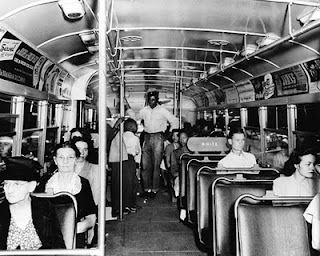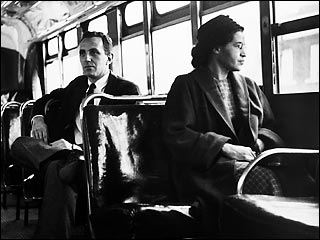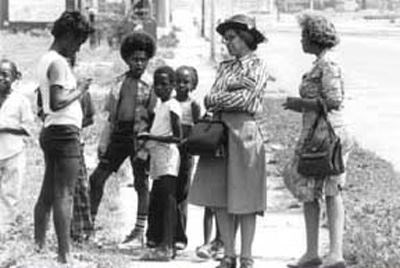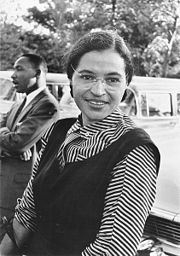"Handle them carefully, for words have more power than atom bombs" (Pearl Strachan). As cliched as it sounds, words truly are powerful. Words can warm hearts, inspire emotions, or damage spirits. Even simple words, such as "yes" or "no" can hold a vast amount of power, depending on the circumstances under which they are used. Perhaps one of the most famous "no's" in history was uttered on December 1, 1955 on a city bus in Montgomery, Alabama. There, a seamstress named Rosa Parks said "no" when she was asked to give up her bus seat, simply because she was "colored". Because of this, she was later arrested for violating a local ordinance. Her arrest marked the beginning of the Montgomery Bus Boycott, and triggered several other events as well, all because she simply said a two-letter word: "no". Even before her bold act of defiance, Rosa Parks exhibited heroic qualities. However, on that particular day, she inspired Americans everywhere to stand up for themselves. With her courage, perseverance, and kindness towards others, Parks influenced numerous people to join her in the battle for equality.
 |
| Segregated Alabama bus. (http://sunnynash.blogspot.com (Birmingham Public Library)) |
By refusing be be taken advantage of on the bus that day, Parks proudly displayed her boldness and bravery to others across the nation, regardless of whether or not they witnessed it firsthand. When Parks boarded the city bus on that December day, she happened to choose a rather unusual seat that evening. She "sat down in an empty section [of seats] often referred to as 'no man's land'" (Lee, Chana Kai). During this time, only whites were allowed to sit in the first ten rows of the seats, and the "colored" passengers were expected to sit in the back. Parks chose to sit directly behind the whites-only section, in an area that nobody else was brave enough to sit in, for fear of what was called "civil disobedience" at the time. Once the seat in the front of the bus had filled up, however, Parks was asked to give up her seat to a white passenger, and refused, despite the potential consequences she faced. "Blake [the bus driver] threatened to call for the police if she did not do as he asked, but Parks still refused ["quietly and calmly" (Baggett, Tammy K.)] to stand up. She had been arrested that evening for refusing to relinquish her seat to a white patron, thereby violating the segregation laws of Montgomery" (Marks-Ellis, Annette). Even when threatened with the possibility of imprisonment, Parks would not allow herself to be compromised and stood up for what she believed in. Plus, not only did Parks make an impression by refusing to move despite arrest, but she proved her point "quietly and calmly". This just goes to show that one doesn't need to use violence to influence others. Moreover, even after being taken into custody, Parks continued to hold her head up high and fight for the rights of people like herself.
 |
| Parks riding a city bus in December 1956. ((http://www.freewebs.com)) |
Aside from being apprehended due to her "civil disobedience" on the bus, Parks endured several other trials during her fight for equality. After her refusal on the bus, Parks launched a nationwide domino effect that caused many others to join her cause. Her arrest brought about the proposal of a bus boycott that hundreds of people took part in. "The 381 days of boycotting led to the banning of segregation on municipal buses" (Marks-Ellis, Annette). After 381 days of refusing to ride buses, Parks' work finally paid off when the kind of segregation that caused her arrest would no longer be legal. The boycott, which had been originally planned to last only a single day, lasted for much longer than expected. Parks must have had great faith and perseverance to go for such an extensive period of time like that, unsure whether what she was doing was actually helping to make a change in things. However, once her cause had started gaining success, as well as attention, people began to fight back against her ideas. "Parks and her husband endured many reprisals in response to their involvement, not the least of which was losing their jobs. Neither was employable after the boycott. By August 1957 Parks had left Montgomery for Detroit... Parks continued her activism." (Lee, Chana Kai). Not only was Parks suffering for this, but her husband was involved as well. Yet when things became difficult, they both simply moved elsewhere and continued what they were doing. Rather than fighting back with methods such as violence, Parks and her husband simply turned the other cheek and moved to another location so they could continue their struggle for equality. The perseverance that Parks and her husband had helped them to endure such trials, and worked to strengthen them in their journey against racism.
 |
| Rosa Parks talking to young people. (http://www.achievement.org (Andrew Sacks)) |
Not only was Rosa Parks brave and persistent, but she also had a kind heart that helped others. Along with leading boycotts and protesting against segregation, Parks was also helping people long before that. "Despite personal tragedy and failing health, she continued to work tirelessly for the rights of all people. In 1980 she joined her voice to those calling for an end to apartheid in South Africa and in 1988 opened the Rosa and Raymond Parks Institute for Self-Development, a career counseling center" (Marks-Ellis, Annette). Parks worked, despite her own problems, to help others everywhere. Here, Parks, along with her husband, weren't boycotting or protesting; they were working to improve the lives of those less fortunate by donating time and expense that they could have used elsewhere. Also, even before any of this happened, Parks still demonstrated her selflessness in one particular incident. "Parks' education at the Alabama State Teachers College was cut short when she left school at 16 to take care of her ailing grandmother. To help support her family, she learned how to type and took in sewing" (Newsmakers). When she was much younger, Parks gave up her education to care for her family. She gave up her future to help the ones she loved. Not only that, but she also learned how to type and sew; she improvised, and created a new future for herself, all to support her family. Rosa Parks' selflessness is one of the various reasons she was able to influence such a prevalent amount of people. She touched the lives of many with her kindness towards others.
 |
| Parks with Dr. Martin Luther King Jr. (http://en.wikipedia.org/wiki/Rosa_Parks ()) |
By refusing to be trodden on, Parks started a chain reaction of events that would ultimately end legal segregation in America. With her courage, kindness, and perseverance, Parks inspired and influenced others all across the country. If Parks hadn't chosen to defy the law that December day, things might be different today. Many people in this country, myself included, might not have been given the same rights as we have now. I might be living a different life if Rosa Parks had said "yes" that day, rather than "no". She showed us that a single person can make a difference by doing simple things, like merely saying no. Parks stood up for herself, setting an example that countless others would soon adopt and follow. In doing this, she made American history, and it was all because of a two-letter word.
Benson, Sonia, Daniel E. Brannen, Jr., and Rebecca Valentine. U*X*L Encyclopedia of U.S. History. Lawrence W. Baker and Sarah Hermsen. Vol. 6. Detroit: UXL, 2009. Gale Virtual Reference Library. DEL NORTE HIGH SCHOOL. 24 Mar. 2012.
Lee, Chana Kai. "Rosa Parks." American National Biography. 1st ed. 2010. Biography Reference Center. EBSCO. DEL NORTE HIGH SCHOOL. 27 Mar. 2012
Marks-Ellis, Annette, and Marks-Ellis Annette. "Rosa Parks." Great Lives From History: The Twentieth Century. 2008. Biography Reference Center. EBSCO. DEL NORTE HIGH SCHOOL. 26 Mar. 2012.
"Official Website - Rosa and Raymond Parks Institute." Official Website - Rosa and RaymondParks Institute. 2012. Rosa & Raymond Parks Institute for Self Development. April 10, 2012.
"Rosa Parks." Newsmakers. Detroit: Gale, 2007. Web. (2007) Gale Biography In Context. Gale. DEL NORTE HIGH SCHOOL. March 21, 2012.
Lee, Chana Kai. "Rosa Parks." American National Biography. 1st ed. 2010. Biography Reference Center. EBSCO. DEL NORTE HIGH SCHOOL. 27 Mar. 2012
Marks-Ellis, Annette, and Marks-Ellis Annette. "Rosa Parks." Great Lives From History: The Twentieth Century. 2008. Biography Reference Center. EBSCO. DEL NORTE HIGH SCHOOL. 26 Mar. 2012.
"Rosa Parks." Newsmakers. Detroit: Gale, 2007. Web. (2007) Gale Biography In Context. Gale. DEL NORTE HIGH SCHOOL. March 21, 2012.Page created on 4/18/2012 12:00:00 AM
Last edited 4/18/2012 12:00:00 AM
